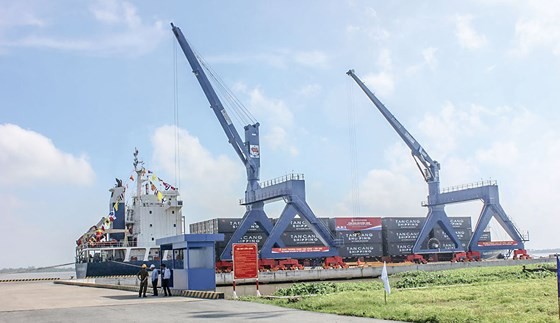
The Mekong Delta now has four major methods of transport namely road, seaway, inland waterway and airway. Currently regional connectivity has not attracted appropriate attention.
Limitation in main traffic axes connecting production and consumption has affected socioeconomic development of localities in the region. This has caused high logistics costs.
Currently, over 85 percent of seaports in the delta are of small scale. They have mainly served loading and unloading demand of bulk cargo with a shortage of container ports. The region has 32 wharfs but only six of them are capable for container handling service with three locating in Can Tho city.
For the last past, many international shipping lines have been afraid of arriving at seaports in the Mekong Delta fearing transport cost increase. Their vessels are full of cargo when arriving in the delta but leaving empty or with insufficient goods.
The fairway for heavy loaded vessels to get in and out from seaports in the Hau river has been opened in Quan Chanh Bo canal. Still it just permits one way travel for large vessels. Lots of businesses have proposed to rationalize traffic segregation to prevent congestion from occurring when there are lot of boats travel in the route. They suggested dredging Dinh An passage to enable more large boats to enter the Hau river.
Mr. Nguyen Thanh Han, director general of Gennuine Partners Group, said that investment attraction policies play a very important role in developing logistics service in Can Tho city in separate and the Mekong Delta in general. Logistics development not only comprises seaports but also needs coordination among fields of customs, warehouses and other relevant services such as goods quality verification. They all should be developed and connected synchronously.
Currently, logistics service in the Mekong Delta has just been in the first phase of development and not fully promoted its role to contribute in boosting production and exports especially trading of farm produce, which is the region’s strength.
According experts, the Mekong Delta will save over VND2 trillion if reducing one percent of logistics costs a year.
Mr. Nguyen Minh Toai, director of the Department of Industry and Trade in Can Tho city, said that cargo export import and transport demand has been increasing in the Mekong Delta amid international integration and competition, so the region needs a modern logistics system able to meet cost reduction requirement and raise the competitive ability for commodities in the region.
Most of commodities in the Mekong Delta have been transited to ports in the southeast region for export. That has raised transport cost by at least US$10 a ton, he added.
Mr. Pham Anh Tuan, deputy director general of Portcoast Consultant Corporation, said that the Mekong Delta is the country’s major agricultural production zone with important role in developing the country’s economy. Hence it is needed to develop logistics service to facilitate trade and improve the competitive ability of farm produce in the region.
In order to step up logistics development, many businesses suggested central and local authorities to pay attention to solving knots in large transport by opening cargo transport flights to better exploitation of Can Tho airport, upgrading road infrastructure for cargo transport and soon open railway to the Mekong Delta.
Three important factors of logistics are large transport, port yard infrastructure and logistics service. If problems in large transport are solved, the development of the remaining phases will be boosted.
























